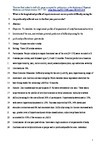What is the longitudinal profile of impairments and can we predict difficulty caring for the profoundly-affected arm in the first year post-stroke?
| dc.contributor.author | Allison, R | |
| dc.contributor.author | Kilbride, C | |
| dc.contributor.author | Chynoweth, Jade | |
| dc.contributor.author | Creanor, Siobhan | |
| dc.contributor.author | Frampton, I | |
| dc.contributor.author | Marsden, Jonathan | |
| dc.date.accessioned | 2017-10-24T09:11:11Z | |
| dc.date.issued | 2017-09-01 | |
| dc.identifier.issn | 0003-9993 | |
| dc.identifier.issn | 1532-821X | |
| dc.identifier.uri | http://hdl.handle.net/10026.1/10084 | |
| dc.description.abstract |
OBJECTIVE: To establish the longitudinal profile of impairments of body functions and activity limitations of the arm, and evaluate potential predictors of difficulty caring for the profoundly-affected arm post-stroke. DESIGN: Prospective cohort study. SETTING: Three UK stroke services. PARTICIPANTS: People unlikely to regain functional use of the arm (N=155) were recruited at 2-4 weeks post-stroke, and followed up at 3, 6 and 12 months. Potential predictors at baseline were hypertonicity, pain, motor control, mood, sensation/perception, age and stroke severity. INTERVENTIONS: NA MAIN OUTCOME MEASURES: Difficulty caring for the arm (LASIS), pain, hypertonicity, range of movement, arm function and skin integrity. Multi-variable linear regression identified the best fitting model for predicting LASIS at 12 months. RESULTS: One hundred and ten participants (71%) were reviewed at one year. There was a large variation in the profile of arm functions and activity limitations. Inability or severe difficulty caring for the arm affected 29% of participants. Hypertonicity developed in 77%, with severe hypertonicity present in 25%. Pain was reported by 65%, 94% developed shoulder contracture and 6% had macerated skin. Difficulty caring for the arm increased with age, greater level of hypertonicity and stroke classification; collectively these factors accounted for 33% of the variance in LASIS. CONCLUSIONS: At one year post-stroke, there was a high incidence of impairments of body functions and activity limitations in people with a profoundly-affected arm. Individual profiles were very variable and although some pre-disposing factors have been identified, it remains difficult to predict who is at greatest risk. | |
| dc.format.extent | 433-442 | |
| dc.format.medium | Print-Electronic | |
| dc.language | en | |
| dc.language.iso | en | |
| dc.publisher | Elsevier BV | |
| dc.subject | contracture | |
| dc.subject | pain | |
| dc.subject | spasticity | |
| dc.subject | stroke | |
| dc.subject | upper limb | |
| dc.title | What is the longitudinal profile of impairments and can we predict difficulty caring for the profoundly-affected arm in the first year post-stroke? | |
| dc.type | journal-article | |
| dc.type | Journal Article | |
| dc.type | Research Support, Non-U.S. Gov't | |
| plymouth.author-url | https://www.ncbi.nlm.nih.gov/pubmed/28866012 | |
| plymouth.issue | 3 | |
| plymouth.volume | 99 | |
| plymouth.publication-status | Published online | |
| plymouth.journal | Arch Phys Med Rehabil | |
| dc.identifier.doi | 10.1016/j.apmr.2017.07.016 | |
| plymouth.organisational-group | /Plymouth | |
| plymouth.organisational-group | /Plymouth/Faculty of Health | |
| plymouth.organisational-group | /Plymouth/Faculty of Health/Peninsula Medical School | |
| plymouth.organisational-group | /Plymouth/Faculty of Health/School of Health Professions | |
| plymouth.organisational-group | /Plymouth/REF 2021 Researchers by UoA | |
| plymouth.organisational-group | /Plymouth/REF 2021 Researchers by UoA/UoA03 Allied Health Professions, Dentistry, Nursing and Pharmacy | |
| plymouth.organisational-group | /Plymouth/Research Groups | |
| plymouth.organisational-group | /Plymouth/Research Groups/FoH - Applied Parkinson's Research | |
| plymouth.organisational-group | /Plymouth/Research Groups/Institute of Health and Community | |
| plymouth.organisational-group | /Plymouth/Research Groups/Institute of Translational and Stratified Medicine (ITSMED) | |
| plymouth.organisational-group | /Plymouth/Research Groups/Institute of Translational and Stratified Medicine (ITSMED)/CBBB | |
| plymouth.organisational-group | /Plymouth/Users by role | |
| plymouth.organisational-group | /Plymouth/Users by role/Academics | |
| dc.publisher.place | United States | |
| dcterms.dateAccepted | 2017-07-24 | |
| dc.rights.embargodate | 2018-9-1 | |
| dc.identifier.eissn | 1532-821X | |
| dc.rights.embargoperiod | Not known | |
| rioxxterms.versionofrecord | 10.1016/j.apmr.2017.07.016 | |
| rioxxterms.licenseref.uri | http://www.rioxx.net/licenses/all-rights-reserved | |
| rioxxterms.licenseref.startdate | 2017-09-01 | |
| rioxxterms.type | Journal Article/Review |


